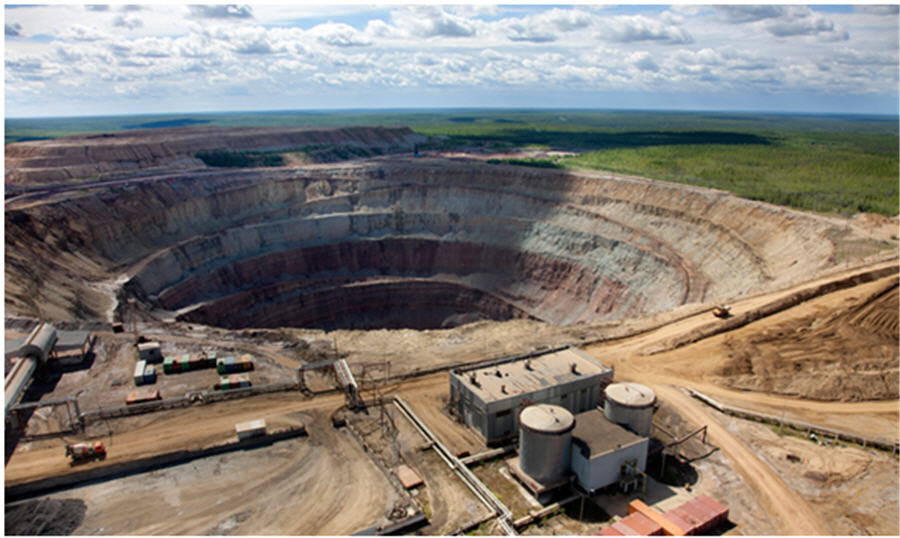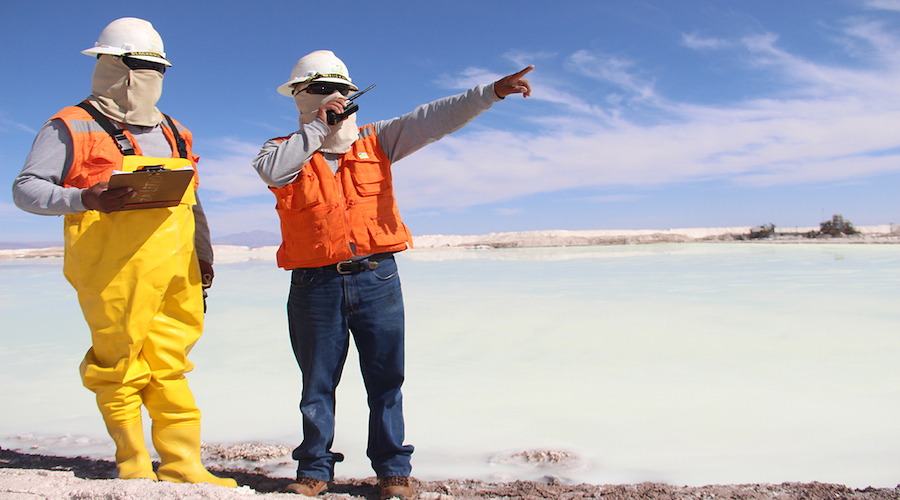2017 global natural diamond production forecasted at 142M carats worth $15.6B
Mined diamond production in 2017 is estimated to be 142.3 million carats worth $15.6B (see appendix below), which would be an 11.5% increase in carat volume produced over 2016 and an 9.9% increase in total value produced, Paul Zimnisky’s Rough Diamond Index shows.
The top 10 largest mines in the world by value produced are estimated to represent 58% of global production. De Beers’ Jwaneng mine in Botswana is ranked number one, and is estimated to independently produce 15% of the world’s diamonds in value.
Russia is estimated to be the largest producing nation by value at 35%, followed by Botswana at 22%, Canada at 14%, Angola at 8%, South Africa at 7%, Namibia at 5%, and Australia at 3%.
Russia
Russian diamond production is dominated by ALROSA (RTS: ALRS) which is 58% owned by Russian national and regional governments. The company’s prized Jubilee mine is estimated to produce 9.2M carats worth $1.4B in 2017, which by itself represents 9% of global diamond output by value. Company-wide, ALROSA’s portfolio includes 11 mines and 5 alluvial operations, producing 27% of global diamond production by volume and 33% by value (see Figure 1 for complete company-wide production figures of major producers).
ALROSA also owns two of only three new diamond mines in development globally with expected capacity to produce in excess of 1M carats annually (see Figure2).
Outside of ALROSA the only other notable commercial diamond mine in Russia is the Grib mine. In the early 2000’s Russian integrated oil company LUKoil (RTS: LKOH) acquired the rights to the Grib resource for an estimated $15M, an offer the company viewed as too good to refuse even though diamonds were outside the scope the energy company’s core business. A decade later LUKoil made a capital commitment of over $850M to build the mine and Grib production commenced in 2014. For years LUKoil has been transparent in its interest in selling the non-core asset, and finally came to terms with Russian financial conglomerate Otkritie Holding Group (private) in late 2016 which agreed to buy the mine for $1.45B. In 2017 Grib is estimated to produce over 4M carats worth over $350M.
Botswana
In 2013 De Beers moved its sorting and sales operations from London to Gaborone making Botswana the core location of its business. The government of Botswana owns 15% of De Beers group outright and 50% of Debswana, the De Beers/Botswana joint venture.
De Beers’ two primary mines in Botswana, Jwaneng and Orapa, represent 92% of the nation’s diamond output by value. Jwaneng is arguably the most valuable diamond mine in the world, and De Beers just recently began accessing ore from the new Cut-8 expansion portion of the mine’s ore body. The $2.2M, 7-year expansion project will extend the mine’s life to beyond 2040. Jwaneng’s diamonds are worth on average ~$200/ct, which compares to an average price of ~$150/ct for diamonds from Jubilee, ALROSA’s most prolific mine, and a global-mine average of $110/ct (see appendix).
Lucara’s (TSX: LUC) Karowe mine ranks as the third largest diamond mine in Botswana by value produced. The mine is only estimated to produce 300,000 carats this year, but at an average price-per-carat of almost $700/ct making Karowe’s diamonds the second most valuable in the world on an average price-per-carat basis not including alluvial mines. Gem Diamonds’ (LSE: GEMD) Letšeng mine in Lesotho is estimated to produce just over 100,000 carats at $1,800/ct, and Lucapa Diamonds’ Lulo alluvial mine in Angola is estimated to produce diamonds with an average price-per-carat of $2,400/ct in 2017.
This year Lucara will continue to mine the South Lobe portion of the Karowe ore body which produced the Lesedi La Rona in 2015, which is second-largest rough gem-diamond ever produced is expected to sell for $70-85M this year.
Canada
Canada is arguably the most active nation in the global diamond mining scene. The country hosts five large-scale diamond mines with state-of-the-art infrastructure, two of which are the newest world-class diamond mines in the world, Gahcho Kué and Renard. Three of the five largest players in the industry, De Beers, Rio Tinto (LSE: RIO), and Dominion Diamond (TSX: DDC) own assets in Canada, and the nation also has the most robust diamond development project pipeline in the world (see Figure 2).
Gahcho Kué and Renard are estimated to bring to market 4.5M carats of incremental supply this year worth $500M, with the two mines contributing about a third of the estimated 14.7M carat increase is global diamond output in 2017 over 2016. Most of the balance of additional supply in 2017 is likely to come from De Beers, ALROSA and Rio Tinto increasing production relative to capacity. For example, De Beers currently has approximately 35M carats of production capacity and is estimated to produce 32M carats or 91% of capacity this year, whereas the company only produced 83% of capacity in 2016.
On the exploration/development front, multiple Canadian firms are advancing what have the potential to be world-class mines. Peregrine Diamonds (TSX: PGD), which is currently expanding the resource at it’s Chidliak project in Nunavut, has the potential to eventually produce over a million carats a year worth in excess of $200/carat. Shore Gold (TSX: SGF) is updating the feasibility study on it’s Star-Orion project in Saskatchewan after working to optimize overburden removal and recovery options. If put into production Star-Orion has the potential to produce well over a million carats annually at a mine life that could exceed 50 years. Just this week (the first week of May 2017), Kennady Diamonds (TSX: KDI) and North Arrow Minerals (TSX: NAR) announced a raise of C$10M and C$5M to advance their Kennady North and Naujaat projects in the North West Territories and Nunavut, respectively.
Angola
Angola is the fourth largest diamond producer in the world by value with approximately 75% of the nation’s production coming from one mine, Catoca. Catoca is owned by four entities, primarily Endiama, the Angolan-state diamond miner, and ALROSA, and is estimated to produce 6.5M carats this year worth over $600M.
Endiama and ALROSA are also partners in what could be the most significant new diamond discovery in decades, the Luaxe project. Luaxe could be as large as 350M carats with the potential to produce over 10M carats annually. Production could commence by the end of the decade, although neither Endiama or ALROSA have released any official figures.
Small Angolan alluvial miner Lucapa Diamonds (ASX: LOM) has made headlines in recent months with multiple exceptional diamond discoveries including a 404-carat Type-IIa colorless diamond, the largest gem-diamond ever found in Angola, which sold for $16M last year. Lucapa’s Lulo mine is estimated to produce the highest average-price-per carat diamonds in the world in 2017 at $2,400/ct.
South Africa
The majority of South African diamond production in 2017, over 60%, is estimated to come from De Beers’ Venetia mine and Petra Diamonds’ (LSE: PDL) Finsch mine.
Venetia, South Africa’s largest mine, is currently being converted to an underground mine which will extend the life of mine beyond 2023 which is when the open-pit operation will be phased out. The $2B project is progressing on schedule.
Petra diamonds holds a portfolio of four ex-De Beers South African mines. Petra (the company also owns a mine in Tanzania) is forecasted to grow company-wide production by over 40% to 5.3M carats by 2019 with growth primarily coming from underground expansion projects at Finsch and Cullinan which will result in higher production as higher concentrated ore is accessed.
The Cullinan mine has been in production for over 100 years and is known for producing the largest gem-quality diamond in history, the 3,106 carat Cullinan Diamond. Upon completion of the current expansion project the mine is estimated to operate for at least another 25 years.
Namibia
Namibia is the fifth largest diamond producing nation in the world and all of the country’s production is alluvially mined.
De Beers’ offshore mining operation, Debmarine, produces over half of Namibia’s diamonds by volume and value. Debmarine is currently the only large-scale marine mining operation in the world, however, Canadian-based Nautilus Minerals (TSX: NUS) is developing a seafloor production technology targeting not diamonds but seafloor massive sulfides off of Papua New Guinea which are rich in gold, copper, silver and zinc. In April the company began testing its recently delivered custom seafloor production tools.

One of Nautilus Mineral’s seafloor production tools for mining precious and base metals. Source: Nautilus Minerals
Australia
Over 99% of Australian diamond production comes from one mine, Rio Tinto’s Argyle mine. In 2017, Argyle is estimated to produce 17M carats which would be a 21% increase year-over-year making it the largest volume producer in the world, however the mine is reaching exhaustion.
Current plans are to keep Argyle open until 2021, however if Rio does not proceed with the second stage of the underground block cave (which could be the company’s implication according to recent management dialoged), the mine would close even earlier. Last year Rio took a $241M impairment charge on Argyle due to “lower production volumes compared with forecast and lower prices achieved for bulk diamonds.” The large majority Argyle diamonds are small and low in quality and color, but highly valuable Argyle pink and red diamonds have made the mine economic.
—
De Beers is 85% owned by Anglo American plc (LSE: AAL) and 15% owned by the Government of the Republic of Botswana.
At the time of writing Paul Zimnisky held a long covered-call position in Dominion Diamond Corp.
Paul Zimnisky is an independent diamond industry analyst and publisher of the Zimnisky Global Rough Diamond Price Index. Paul can be contacted at paul@paulzimnisky.com and followed on Twitter @paulzimnisky.
***
Paul Zimnisky is an independent analyst and consultant, specializing in the diamond market. He can be reached at paul@paulzimnisky.com.
More News
{{ commodity.name }}
{{ post.title }}
{{ post.date }}











Comments